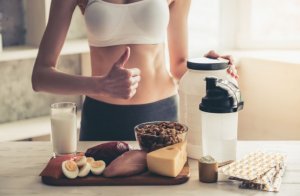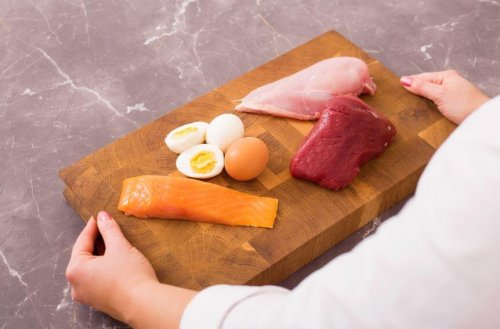High-Protein Diet: slim down and gain muscle mass

If you want to slim down and gain muscle mass at the same time, you should consider a high-protein diet. Below, we’ll explain what it is and how to get started in a healthy way for good results. As with any kind of diet, you should follow a high-protein diet under medical supervision. Otherwise, you could suffer the consequences that you’ll learn about later on in this post.
What is a high-protein diet?
Physically active people who want to lose fat and build muscle often follow a high-protein diet. It’s a diet where dieters considerably increase their protein intake in order to build muscle mass. In addition, they reduce their carbohydrate and fat intakes as much as possible.
Along with performing regular exercise, dieters can follow a high-protein diet to increase muscle mass much faster than by just exercising. In addition, dieters drop the weight and reduce their fat reserves by avoiding fats.

How to follow a high-protein diet
Now that you’re familiar with the high-protein diet, we’ll explain the steps that you need to take to start, in a healthy, safe way that’ll guarantee results. As you’ll read shortly, getting started is simple and won’t require spending hours in the kitchen. Neither will it require buying food products that are hard to find. In addition, the best part about this diet is that it’ll keep you feeling full, meaning that you won’t have to be a hungry dieter.
- Eat carbohydrates only at breakfast. As we mentioned earlier, carbohydrates are limited in this diet. So, you can only consume them during your first meal of the day, and by consuming the most natural sources possible.
- Don’t skip meals. Though it’s a filling diet, you need to eat five meals a day. It’s the only way to give your body the energy that it needs throughout the day and to prevent binge-eating.
- Seventy-five percent of each meal should be made up from protein. At the very least, try to make sure that at least half of every meal that you have is based on protein. Increase protein to seventy-five percent for lunch and dinner. Remember that it’s a fundamental nutrient for building muscle.
- Don’t forget to stay hydrated. Drink water, smoothies, and natural juices while following the diet. Doing so will provide you with the protein and hydration that you need.

Dangers of a high-protein diet
As we commented earlier in our post, the high-protein diet consists of increasing protein consumption while reducing carbohydrates and fats. This kind of diet isn’t healthy to sustain over a long period of time. In light of this, we recommend starting one only under medical supervision. Failing to do so might lead you to suffer the following consequences:
- Risk of developing gout. The increased protein consumption could lead to an increase in uric acid levels over time. As a consequence, you could develop gout and it’s a painful condition.
- Tiredness. The body needs all kinds of nutrients to correctly carry out all of its functions. So, after it fails to consume enough fat over a long period of time, you might find your body feeling tired more often.
- Kidney and liver damage. Ingesting large amounts of proteins could overwork the kidneys and liver.
All in all, we’re not saying that a high-protein diet is dangerous, or that we don’t recommend it. Equally, neither are we suggesting that it’s a miracle diet. The only point we must make is that you should begin this under professional supervision and only for a set amount of time. That’s the only way to reach your goals and avoid any risks.
If you want to slim down and gain muscle mass at the same time, you should consider a high-protein diet. Below, we’ll explain what it is and how to get started in a healthy way for good results. As with any kind of diet, you should follow a high-protein diet under medical supervision. Otherwise, you could suffer the consequences that you’ll learn about later on in this post.
What is a high-protein diet?
Physically active people who want to lose fat and build muscle often follow a high-protein diet. It’s a diet where dieters considerably increase their protein intake in order to build muscle mass. In addition, they reduce their carbohydrate and fat intakes as much as possible.
Along with performing regular exercise, dieters can follow a high-protein diet to increase muscle mass much faster than by just exercising. In addition, dieters drop the weight and reduce their fat reserves by avoiding fats.

How to follow a high-protein diet
Now that you’re familiar with the high-protein diet, we’ll explain the steps that you need to take to start, in a healthy, safe way that’ll guarantee results. As you’ll read shortly, getting started is simple and won’t require spending hours in the kitchen. Neither will it require buying food products that are hard to find. In addition, the best part about this diet is that it’ll keep you feeling full, meaning that you won’t have to be a hungry dieter.
- Eat carbohydrates only at breakfast. As we mentioned earlier, carbohydrates are limited in this diet. So, you can only consume them during your first meal of the day, and by consuming the most natural sources possible.
- Don’t skip meals. Though it’s a filling diet, you need to eat five meals a day. It’s the only way to give your body the energy that it needs throughout the day and to prevent binge-eating.
- Seventy-five percent of each meal should be made up from protein. At the very least, try to make sure that at least half of every meal that you have is based on protein. Increase protein to seventy-five percent for lunch and dinner. Remember that it’s a fundamental nutrient for building muscle.
- Don’t forget to stay hydrated. Drink water, smoothies, and natural juices while following the diet. Doing so will provide you with the protein and hydration that you need.

Dangers of a high-protein diet
As we commented earlier in our post, the high-protein diet consists of increasing protein consumption while reducing carbohydrates and fats. This kind of diet isn’t healthy to sustain over a long period of time. In light of this, we recommend starting one only under medical supervision. Failing to do so might lead you to suffer the following consequences:
- Risk of developing gout. The increased protein consumption could lead to an increase in uric acid levels over time. As a consequence, you could develop gout and it’s a painful condition.
- Tiredness. The body needs all kinds of nutrients to correctly carry out all of its functions. So, after it fails to consume enough fat over a long period of time, you might find your body feeling tired more often.
- Kidney and liver damage. Ingesting large amounts of proteins could overwork the kidneys and liver.
All in all, we’re not saying that a high-protein diet is dangerous, or that we don’t recommend it. Equally, neither are we suggesting that it’s a miracle diet. The only point we must make is that you should begin this under professional supervision and only for a set amount of time. That’s the only way to reach your goals and avoid any risks.
This text is provided for informational purposes only and does not replace consultation with a professional. If in doubt, consult your specialist.








